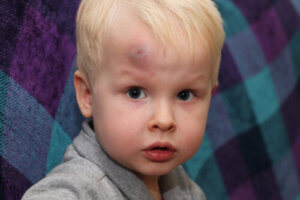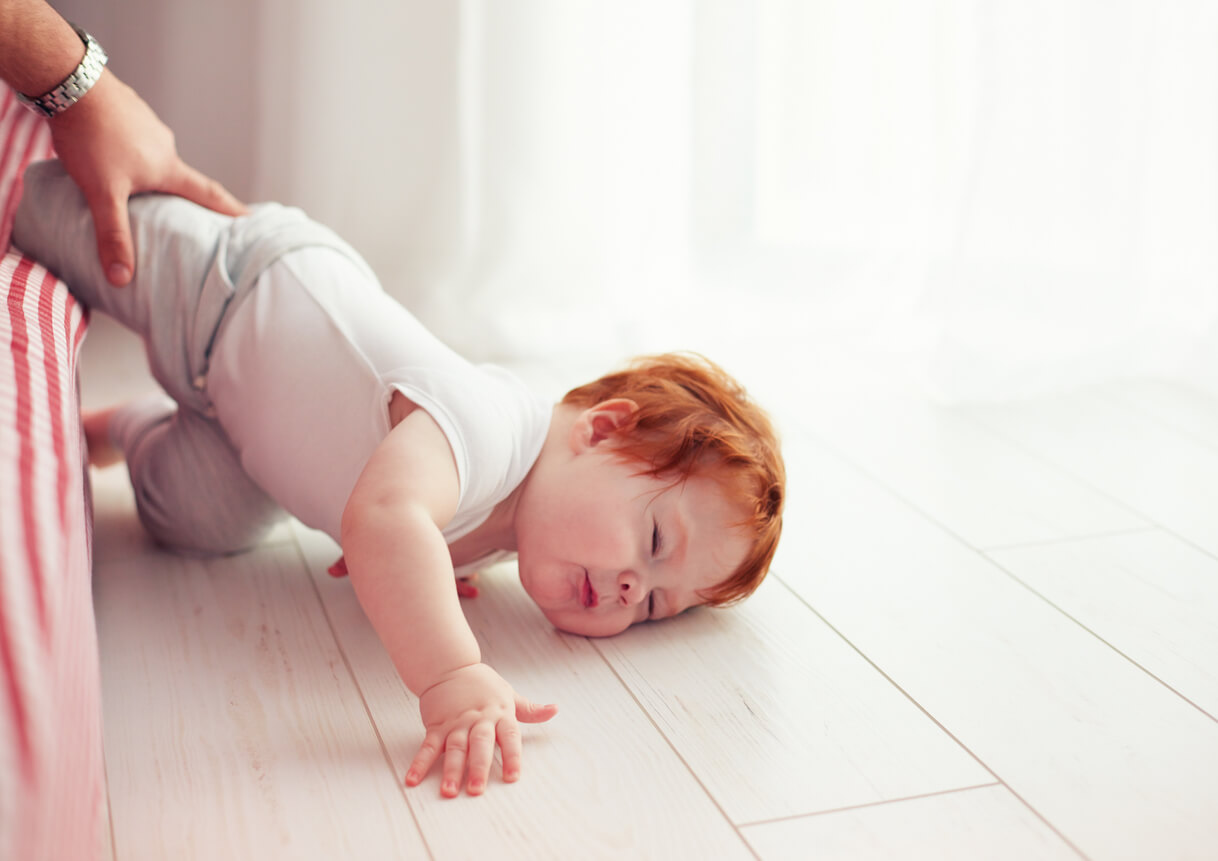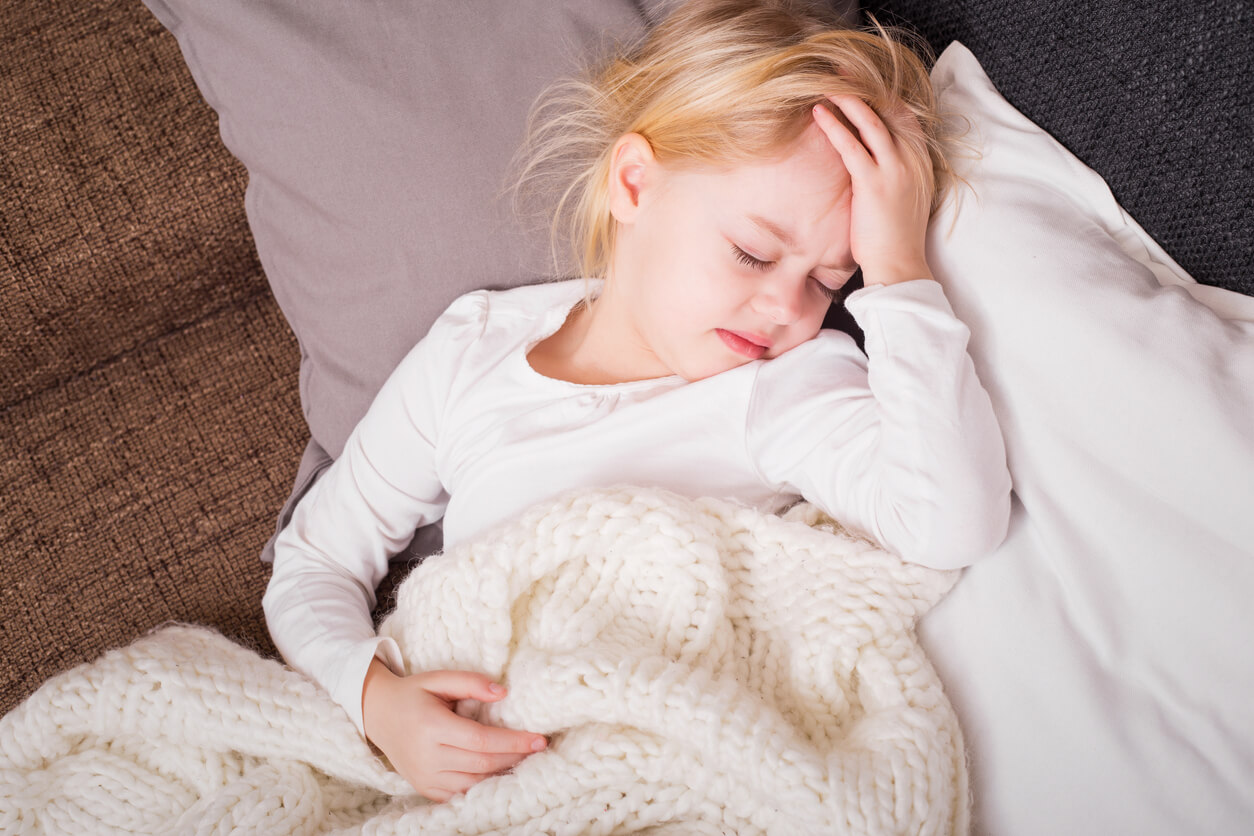What to Do About Children's Bumps?


Written and verified by the dermatologist Maria del Carmen Hernandez
Bumps and blows to the heads of young children are one of the most frequent concerns for parents. In most cases, there’s only a cosmetic discomfort with mild and temporary pain. But on some occasions, this injury needs to be monitored more closely. Here’s what to watch out for when it comes to children’s bumps.
Bumps are inevitable during infancy
Head injuries are very common in children. However, in infants under 1 year of age, closer monitoring is necessary because of the potential consequences. The most frequent causes of children’s bumps are the following:
- Falls from a certain height: For example, from the stroller, changing table, or crib.
- Falls from one’s own height: These occur when the child begins to walk.
For those older than 2 years of age, bumps tend to occur when performing certain recreational activities. For example, when riding skates, bicycles, or playing different games. On the other hand, the most common sites of bruising from childhood trauma are the legs (below the knees), the head, and the T-zone of the face.

What to do when a bump occurs
Most bumps and bruises are superficial. Mild traumatisms, generally, only produce superficial wounds, bruises, and tolerable pain. Here are some tips to keep in mind if your child gets hurt.
Don’t lose control
The main thing is to make sure that the bump is only a superficial injury, especially when it occurs on the head. Then, the child should remain calm, without running or fussing, as should their caregivers. When this type of injury occurs, you can apply essential oils or arnica gels that contribute to reducing the hematoma and stimulating the recovery of the damaged tissue.
Place ice on the area of the injury
The application of cold to the area prevents edema and swelling of the affected area. In fact, immediate icing is one of the most appropriate actions to decrease blood flow around the area and improve the final appearance of the skin.
Provide vitamin K
There are some products on the market that have vitamin K as an essential component. This micronutrient has the ability to decrease the size of bruises and stimulate microcirculation of the skin and subcutaneous cellular tissue. It’s even one of the necessary vitamins used by the body to generate clots and stop bleeding.
Read also: What to Do if My Child Hits Their Head Hard?
Warning signs to watch out for
In general, according to studies published by The Journal of Trauma, when children suffer a minor blow, the pain only appears in the area and can be managed at home. However, parents should always be aware of the symptoms and warning signs that indicate the need for immediate medical attention.
Blows to the head can cause various manifestations, depending on the type of injury, its location, and its severity. Therefore, be on alert for the following signs and symptoms:
- Vomiting
- Excessive sleepiness
- Intense headache
- Irritability
- Blurred vision
- Impaired speech, gait, or coordination
You may be interested in: 10 Home Remedies for Bumps in Children
When should I take my child to the emergency center?

Whenever a child has suffered a major trauma, they should always be evaluated by a physician. The specialist will perform appropriate questioning and a detailed physical examination. For example, there’s a test called the Glasgow scale, which is performed in the examination room and determines the severity of the injury caused by the head injury. In addition, depending on the context of the incident, some complementary tests may be requested, such as an X-ray or a CT scan.
Although the initial impression is of a low severity condition, it’s important to observe the child and their state of health during the 24 hours following the incident. This is to promptly detect any change in their behavior and act as soon as possible. In addition, any of the above-mentioned alarm symptoms should be reported to emergency medical services.
Children’s bumps and medical care
A bump on the head can be as minor as a hematoma (bruise), contusion, or a cut wound. It could also produce a concussion, an open or deep cut, a skull fracture, internal bleeding, or other brain injuries.
Although bumps in children are usually minor injuries, in some cases, they may require more complex care or testing. Therefore, if you notice that the child begins with characteristic symptoms such as blurred vision, vomiting, or loss of consciousness, you should go to the emergency room immediately.
Bumps and blows to the heads of young children are one of the most frequent concerns for parents. In most cases, there’s only a cosmetic discomfort with mild and temporary pain. But on some occasions, this injury needs to be monitored more closely. Here’s what to watch out for when it comes to children’s bumps.
Bumps are inevitable during infancy
Head injuries are very common in children. However, in infants under 1 year of age, closer monitoring is necessary because of the potential consequences. The most frequent causes of children’s bumps are the following:
- Falls from a certain height: For example, from the stroller, changing table, or crib.
- Falls from one’s own height: These occur when the child begins to walk.
For those older than 2 years of age, bumps tend to occur when performing certain recreational activities. For example, when riding skates, bicycles, or playing different games. On the other hand, the most common sites of bruising from childhood trauma are the legs (below the knees), the head, and the T-zone of the face.

What to do when a bump occurs
Most bumps and bruises are superficial. Mild traumatisms, generally, only produce superficial wounds, bruises, and tolerable pain. Here are some tips to keep in mind if your child gets hurt.
Don’t lose control
The main thing is to make sure that the bump is only a superficial injury, especially when it occurs on the head. Then, the child should remain calm, without running or fussing, as should their caregivers. When this type of injury occurs, you can apply essential oils or arnica gels that contribute to reducing the hematoma and stimulating the recovery of the damaged tissue.
Place ice on the area of the injury
The application of cold to the area prevents edema and swelling of the affected area. In fact, immediate icing is one of the most appropriate actions to decrease blood flow around the area and improve the final appearance of the skin.
Provide vitamin K
There are some products on the market that have vitamin K as an essential component. This micronutrient has the ability to decrease the size of bruises and stimulate microcirculation of the skin and subcutaneous cellular tissue. It’s even one of the necessary vitamins used by the body to generate clots and stop bleeding.
Read also: What to Do if My Child Hits Their Head Hard?
Warning signs to watch out for
In general, according to studies published by The Journal of Trauma, when children suffer a minor blow, the pain only appears in the area and can be managed at home. However, parents should always be aware of the symptoms and warning signs that indicate the need for immediate medical attention.
Blows to the head can cause various manifestations, depending on the type of injury, its location, and its severity. Therefore, be on alert for the following signs and symptoms:
- Vomiting
- Excessive sleepiness
- Intense headache
- Irritability
- Blurred vision
- Impaired speech, gait, or coordination
You may be interested in: 10 Home Remedies for Bumps in Children
When should I take my child to the emergency center?

Whenever a child has suffered a major trauma, they should always be evaluated by a physician. The specialist will perform appropriate questioning and a detailed physical examination. For example, there’s a test called the Glasgow scale, which is performed in the examination room and determines the severity of the injury caused by the head injury. In addition, depending on the context of the incident, some complementary tests may be requested, such as an X-ray or a CT scan.
Although the initial impression is of a low severity condition, it’s important to observe the child and their state of health during the 24 hours following the incident. This is to promptly detect any change in their behavior and act as soon as possible. In addition, any of the above-mentioned alarm symptoms should be reported to emergency medical services.
Children’s bumps and medical care
A bump on the head can be as minor as a hematoma (bruise), contusion, or a cut wound. It could also produce a concussion, an open or deep cut, a skull fracture, internal bleeding, or other brain injuries.
Although bumps in children are usually minor injuries, in some cases, they may require more complex care or testing. Therefore, if you notice that the child begins with characteristic symptoms such as blurred vision, vomiting, or loss of consciousness, you should go to the emergency room immediately.
All cited sources were thoroughly reviewed by our team to ensure their quality, reliability, currency, and validity. The bibliography of this article was considered reliable and of academic or scientific accuracy.
- Sternbach GL. The Glasgow coma scale. J Emerg Med. 2000 Jul;19(1):67-71. doi: 10.1016/s0736-4679(00)00182-7. PMID: 10863122.
- Kouzi SA, Nuzum DS. Arnica for bruising and swelling. Am J Health Syst Pharm. 2007 Dec 1;64(23):2434-43. doi: 10.2146/ajhp070155. PMID: 18029949.
- Gelineau-Morel RN, Zinkus TP, Le Pichon JB. Pediatric Head Trauma: A Review and Update. Pediatr Rev. 2019 Sep;40(9):468-481. doi: 10.1542/pir.2018-0257. PMID: 31477589.
- Chang LT, Tsai MC. Craniofacial injuries from slip, trip, and fall accidents of children. J Trauma. 2007 Jul;63(1):70-4. doi: 10.1097/01.ta.0000219142.15584.b8. PMID: 17622871.
This text is provided for informational purposes only and does not replace consultation with a professional. If in doubt, consult your specialist.








